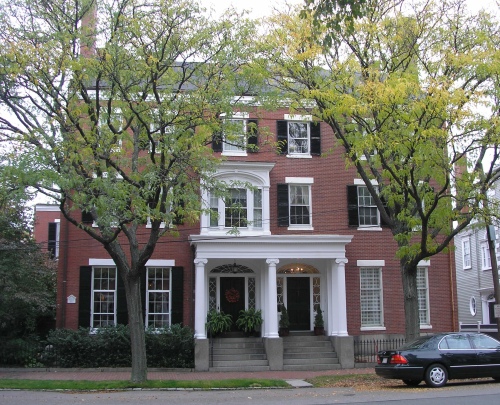Thompson/West Double House (1845)

The double house at at 38-40 Chestnut Street in Salem was built in about 1845 and architecturally represents the transition from the Federal to the Greek Revival style. The original resident of the west half of the house (until 1859) was Rev. James W. Thompson, while the other half was the residence of Captain Nathaniel West, Sr. As described in History of the Military Company of the Massachusetts, Now Called the Ancient and Honorable Artillery Company of Massachusetts. 1637-1888, Vol. III.-1822-1865 (1898), by Olver Ayer Roberts:
Rev. James W. Thompson, D. D., of Salem, delivered the Artillery Election sermon of 1833. He was a son of Rev. James Thompson, D. D., of Barre, Mass., and was born in that town Dec. 13, 1805. He graduated at Brown University in 1827, and at the Theological School of Harvard University in 1831. Prior to his graduation he was ordained to the Christian ministry. He settled first in Natick. An invitation to settle over the Independent Congregation Society, in Barton Square, Salem, was accepted by him, and he was installed March 7, 1832. He remained in this ministry twenty-seven years, and resigned March 7, 1859. He left Salem, and accepted an invitation to the Third or Jamaica Plain Parish Church, in 1859, where he continued as sole or senior pastor until his decease, which occurred Sept. 24, 1881. The funeral services were held in the Unitarian Church at Jamaica Plain, and his remains were buried in Salem.
The eastern half of the double house was later home to Joseph B. Andrews, mayor of Salem in 1854-1856. As described in Historical Sketch of Salem, 1626-1879 (1879), by Charles S. Osgood and H.M. Batchelder:
Joseph Andrews served as mayor in 1854-55. He was born in Salem Dec. 10, 1808, and died in Boston Feb. 8, 1869. He was captain of the Salem Light Infantry and brigadier-general of tho State militia, which position he held in 1861, at the opening of the Rebellion. He commanded at Fort Warren, in Boston harbor, and had charge of the State troops sent to that station prior to their departure for the seat of war, and until it ceased to be used for that purpose. He was a bank official.
Captain John B. Silsbee owned the western half of the house in the late 1850’s and 1860’s. The bay window above the left entrance is an early twentieth-century addition.